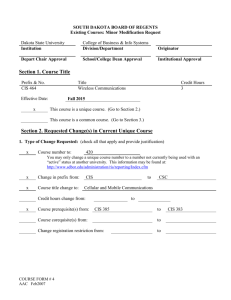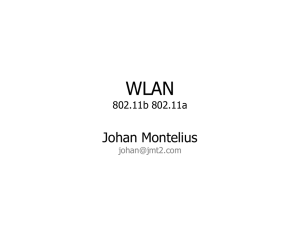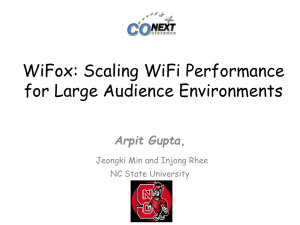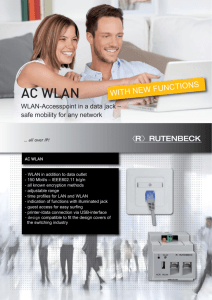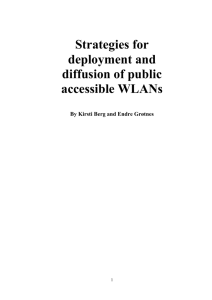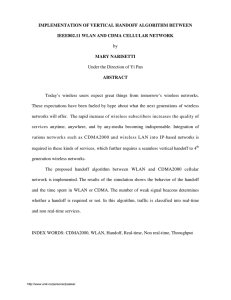Long Distance Wireless Communication Principally satellite
advertisement
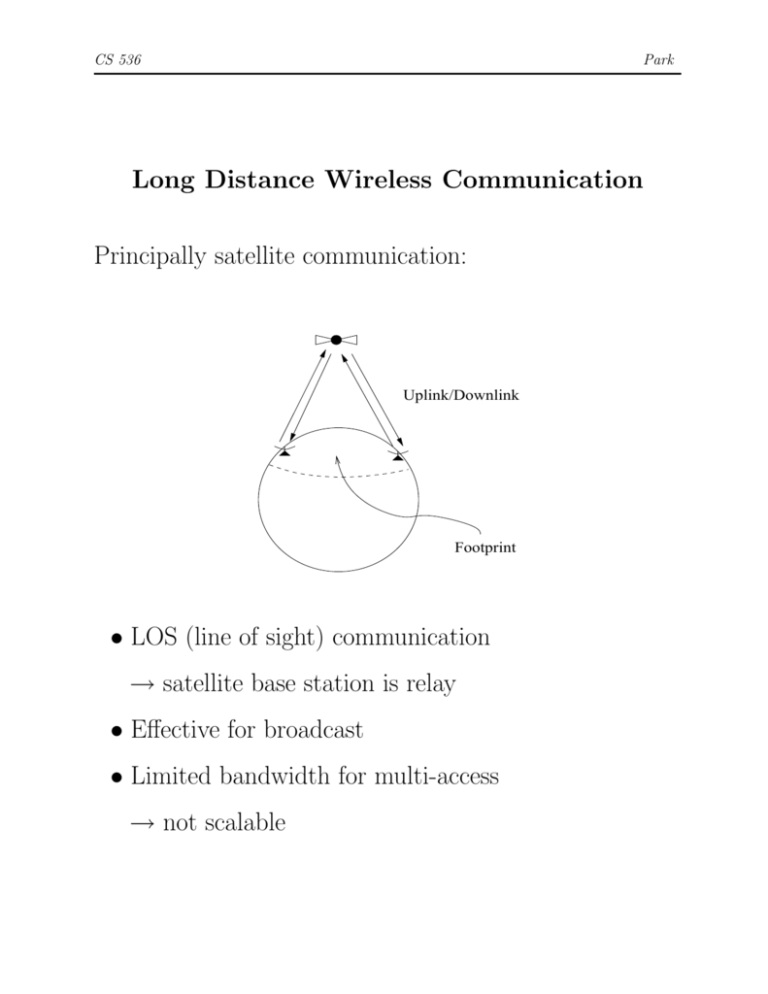
CS 536 Park Long Distance Wireless Communication Principally satellite communication: Uplink/Downlink Footprint • LOS (line of sight) communication → satellite base station is relay • Effective for broadcast • Limited bandwidth for multi-access → not scalable CS 536 Park Multi-access protocols: • FDM + TDMA: dominant −→ broadband −→ GSM cellular • CDMA: e.g., GPS and defense related systems −→ CDMA cellular (Qualcomm) • CSMA/CA: impractical due to large RTT −→ low utilization/throughput Long-distance wireless communication: effective when broadcasting −→ special applications −→ e.g., TV, GPS, digital radio, atomic clock CS 536 Park Short Distance Wireless Communication • very short: wireless PAN • short: wireless LAN • medium: wireless MAN Mobile Mobile Mobile Mobile Base Station Mobile Mobile Stationary −→ TDMA, FDMA, CDMA, polling −→ contention-based multiple access w/o priority CS 536 Park Cellular telephony: frequency & time division F3’ F3 Mobile Mobile F2’ Mobile F1 F1’ Mobile F2 Base Station Mobile Mobile Stationary FDD & TDMA Ex.: GSM (U.S. IS-136) with 25 MHz frequency band • uplink: 890–915 MHz • downlink: 935–960 MHz • 125 channels 200 kHz wide each (= 25000 ÷ 200) → separation needed due to cross-carrier interference → FDM portion CS 536 • 8 time slots within each channel → TDM portion • total of 1000 possible user channels → 125 × 8 (124 × 8 realized) • codec/vocoder: 13.4 kb/s • compare with T1 standard → 24 users at 64 kb/s data rate each Park CS 536 Park Dedicated channels workable because data traffic is speech: • Low bit rate & approximately CBR (constant bit rate) → flat → good/bad? • Not so for: → different for compressed video (e.g., MPEG, H.261) → cf. Terminator video → VBR (variable bit rate) → data files? CS 536 Park Cellular telephony: code division multiplexing C3’ C3 Mobile Mobile C2’ Mobile C1 C1’ Mobile C2 Base Station Mobile Mobile Stationary FDD & CDMA −→ same frequency band; different codes Ex.: IS-95 CDMA with 25 MHz frequency band • uplink: 824–849 MHz; downlink: 869–894 MHz → downlink: prepared; uplink: physical diversity → capture effect: closer station has advantage • codec: 9.6 kb/s CS 536 Park Packet radio: ALOHA F1’ F1 Stationary F1’ Stationary F1 F1’ F1 Base Station Stationary Stationary Stationary ALOHA −→ downlink broadcast channel F 1 −→ shared uplink channel F 10 −→ both baseband Ex.: ALOHANET • data network over radio • Univ. of Hawaii, 1970; 4 islands, 7 campuses CS 536 • Norm Abramson → precursor to Ethernet (Bob Metcalfe) → pioneering Internet technology → parallel to packet switching technology • FM radio carrier frequency → uplink: 407.35 MHz; downlink: 413.475 MHz • bit rate: 9.6 kb/s • contention-based multiple access: MA → plain and simple → needs explicit ACK frames → ALOHA Park CS 536 ALOHA protocol: • send frame (no carrier sense) • wait for ACK → collision detection through explicit ACK • if timeout, retry with probability p −→ looks familiar. . . −→ pure vs. slotted ALOHA Park CS 536 Park Wireless LAN (WLAN): infrastructure mode F1 F1 Mobile Mobile F1 Mobile F1 F1 Mobile F1 Access Point Mobile Mobile Mobile WLAN: Infrastructure Network −→ shared uplink & downlink channel F 1 −→ single baseband channel • basic service set (BSS) • base station: access point (AP) • mobile stations must communicate through AP CS 536 Park WLAN: ad hoc mode F1 F1 Mobile Mobile Mobile F1 Mobile F1 F1 F1 F1 Mobile F1 F1 Mobile F1 Mobile Mobile WLAN: Ad Hoc Network −→ homogeneous: no base station −→ everyone is the same −→ share forwarding responsibility • independent basic service set (IBSS) • mobile stations communicate peer-to-peer → also called peer-to-peer mode CS 536 Park WLAN: internetworking F1 F1 Mobile F1 Mobile F1 Mobile F1 F1 Mobile Mobile F1 Mobile F1 Access Point Mobile Mobile F1 F1 F1 Mobile Mobile F1 Mobile Access Point Mobile Mobile Mobile Distribution System F1 F1 Mobile Mobile Mobile F1 F1 F1 Mobile F1 Access Point Mobile Mobile Mobile WLAN: Extended Service Set −→ internetworking between BSS’s through APs −→ mobility and handoff • extended service set (ESS) • APs are connected by distribution system (DS) CS 536 Park • DS: wireline or wireless → common: Ethernet switch • How do APs and Ethernet switches know where to forward frames? → bridge: link layer forwarding device → i.e., switch using MAC address relay → learning bridge: source address discovery → spanning tree: IEEE 802.1 (Perlman’s algorithm) → distributed ST & leader election CS 536 Additional headache: mobility −→ how to perform handoff −→ mobility management at MAC −→ mobility management at IP (Mobile IP) Mobility between BSSes in an ESS • association → registration process → mobile station (MS) associates with one AP • disassociation → upon permanent departure: notification • reassociation → movement of MS from one AP to another → inform new AP of old AP → forwarding of buffered frames Park CS 536 Park Association, disassociation, reassociation provides necessary information for distribution service within ESS −→ distribution service implemented in AP Compatibility with non-802.11 devices in ESS: −→ integration service: portal abstraction −→ translation service Complicated 802.11 frame format −→ 30-byte MAC header −→ four 48-bit address fields −→ 16-bit frame control field: 11 fields −→ e.g., version, type, subtype, to DS, from DS, . . . −→ type (2-bit): mgt (00), control (01), data (10) −→ subtype (4-bit): association (mgt), ACK (ctl) −→ payload: 0–2313 bytes CS 536 Park WLAN spectrum 2.4–2.4835 GHz: −→ 11 channels (U.S.) −→ 2.412 GHz, 2.417 GHz, . . ., 2.462 GHz Non-interference specification: • each channel has 22 MHz bandwidth • require 25 MHz channel separation −→ thus, only 3 concurrent channels possible −→ e.g., channels 1, 6 and 11 −→ 3-coloring. . . CS 536 Park Examples: Purdue Univ.: IEEE 802.11b (11 Mbps) WLAN network −→ PAL (Purdue Air Link) −→ partial mobility: MAC roaming (within ESS) −→ no mobile IP −→ but football scores at Ross-Ade through PDAs Dartmouth College: IEEE 802.11b WLAN (500+ APs) −→ full VoIP −→ free long distance Seattle, SF, San Diego, Boston, etc.: WiFi communities −→ free Internet access −→ roof-top mesh networks −→ cable & DSL companies don’t like it CS 536 Graffiti: warchalking −→ some cities −→ benevolent kids with lots of free time Soon: integrated WLAN + cellular phones −→ use VoIP when near WLAN network −→ use cellular when outside WLAN coverage −→ automatic switch-over Park

